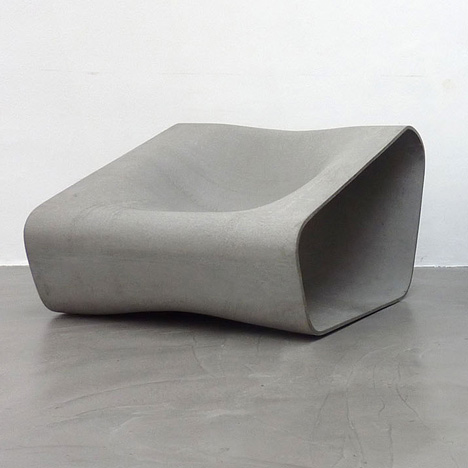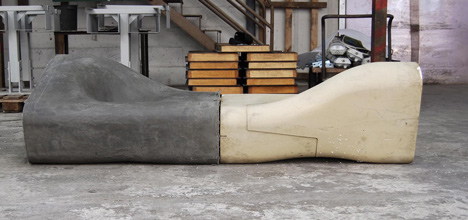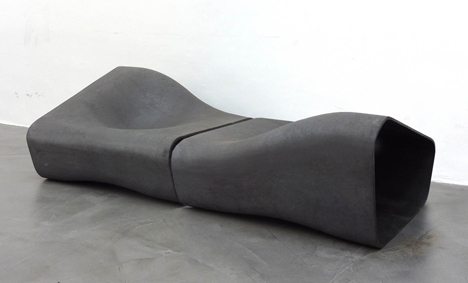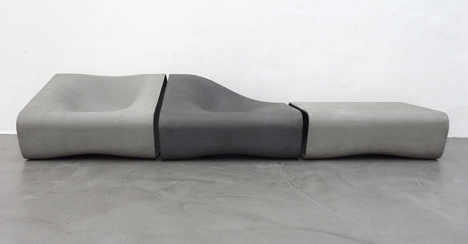Design of outdoor furniture by Rainer Mutsch cement
Diseño de muebles exteriores en fibrocemento por Rainer Mutsch
|
DUNE The background When I saw the very first Eternit – machine, I was amazed: 20 metres long, more than 100 years old and by now of course upgraded with high-tech computers, the very heart of the machine is still the cast-metal construction built back in 1905. This impressive device survived 2 world wars and is until today producing a material which is sold worldwide. The history of the material and its technical potential were part of its fascination and at the same time it was a challenge for me to work with a material that it is, due to its roughness and its primary use as building material, not necessarily associated with furniture design in the first place. But, to quote the Swiss designer Willy Guhl (1915-2004), who designed the Loop-Chair in 1954 “there is no ‚good’ or ‚bad’ material, what makes the difference is its right and adequate use.†The shape For me Dune was a very demanding project, because it depended on so many parameters: ergonomics, durability, capability of mass production, release properties, statics, modularity, and eco friendliness, to mention only a few. Many prototypes and a lot of research were necessary in order to get the maximum stability out of 3d- deformed fiber cement; eventually, the geometry of the chair supports its stability through its controlled expansion and compression of the material. Dune visualizes the present material-technical maximum parametres of the fibercement material. The result is a highly stable structure with a load-carrying capacity way over the demanded requirement profile for public spaces. With Dune I wanted to tell a story about the materials capabilities, the history of the company and the hand formed production method. The shape of all 5 Dune elements now allows the user to move freely on the objects and to choose an individual seating position according to his or her individual taste. This flexibility guarantees at the one hand maximum comfort for the individual and on the other hand facilitates communication when the elements are arranged in a group. Since Dune has been designed as highly modular and indefinitely expandable system, it fits all spatial situations. The possibility of the integration of plants offers an additional possibility to create shadow and to further customize the space. DUNE will be available from spring 2011. The material Produced by the company Eternit fiber-cement is a very durable, fully recyclable material consisting of 100% natural materials like cellulose fibers and water. Fact sheet: A1 – not flammable UV – stable (100% solid-colored) Highly breathable 100% recyclable 100% natural incredients (cellulose fiber and cement) Green Certificate from the “Institut Bauen und Umwelt†Europe 100% frost-resistant Highly durable Each Dune element is 3D-molded out of one whole fiber-cement panel (260 x 110cm), the cut-offs are thereby reduced to a minimum. |
DUNE Los antecedentes Cuando vi la primera máquina de Eternit, me sorprendió: 20 metros de largo, más de 100 años por ahora y por supuesto actualizada con equipos de alta tecnologÃa, el corazón de la máquina sigue siendo la construcción de fundición de metal construida en el año 1905. Este impresionante dispositivo sobrevivió dos guerras mundiales y es hasta hoy la producción de un material que se vende en todo el mundo. La historia del producto y su potencial técnico fueron parte de su fascinación y al mismo tiempo que era un reto para mà trabajar con un material que es, debido a su rugosidad y su principal uso como material de construcción, no necesariamente asociadas con muebles de diseño, en primer lugar. Pero, para citar el diseñador suizo Willy Guhl (1915-2004), quien diseñó el Loop-chair en 1954 "no hay un material bueno o malo, lo que hace la diferencia es su correcto y adecuado uso. " La forma Para mà Dune fue un proyecto muy exigente, ya que depende de muchos parámetros: ergonomÃa, durabilidad, capacidad de producción en masa, la estática, la modularidad y respeto al medio ambiente, por mencionar sólo algunos. Muchos prototipos y un montón de investigación fueron necesarios para obtener el máximo de estabilidad en 3d del fibrocemento deformado; finalmente, la geometrÃa de la silla soporta su estabilidad a través de su expansión controlada y la compresión del material. Dune visualiza los parámetros máximos actuales técnico-material del fibrocemento. El resultado es una estructura muy estable, con una forma de capacidad de carga sobre el perfil de requisitos exigidos para los espacios públicos. Con Duna querÃa contar una historia acerca de las capacidades materiales, la historia de la empresa y el método de producción manual. La forma de los 5 elementos Dune ahora permite al usuario moverse libremente en los objetos y elegir un asiento individual de acuerdo a su gusto individual. Esto garantiza la flexibilidad en la comodidad máxima, por una parte para el individuo y por otro lado facilita la comunicación cuando los elementos están dispuestos en un grupo. Dune ha sido diseñado como un sistema altamente modular y ampliable indefinidamente, se ajusta a todas las situaciones espaciales. La posibilidad de la integración de las plantas ofrece una posibilidad adicional para crear sombra y para personalizar aún más el espacio. DUNE estará disponible a partir de la primavera de 2011. El material Producido por la empresa Eternit de fibrocemento es muy duradero, materiales totalmente reciclables consistentes en materiales 100% naturales como fibras de celulosa y agua. Ficha técnica: A1 - no inflamables UV - estable (100% de un solo color) Muy transpirable 100% reciclable 100% incredients naturales (fibra de celulosa y cemento) Verde Certificado del "Institut Bauen und Umwelt" Europa 100% resistente a las heladas De gran durabilidad Cada elemento de Dune está trazado a partir de un panel entero de fibra-cemento (260 x 110cm), los cortes se reduzca al mÃnimo. |



